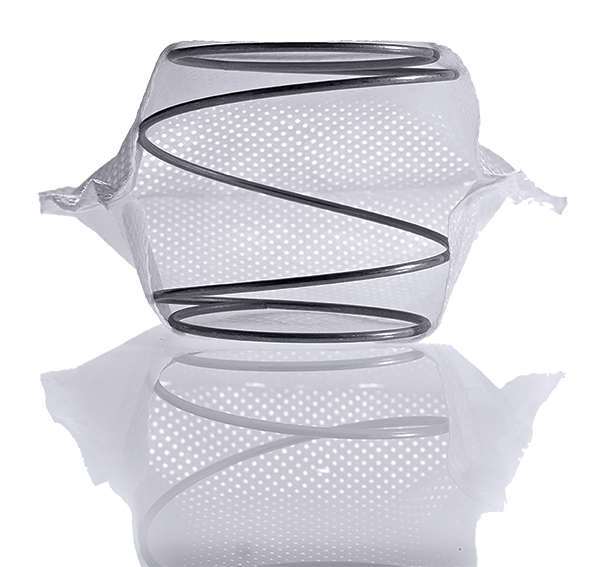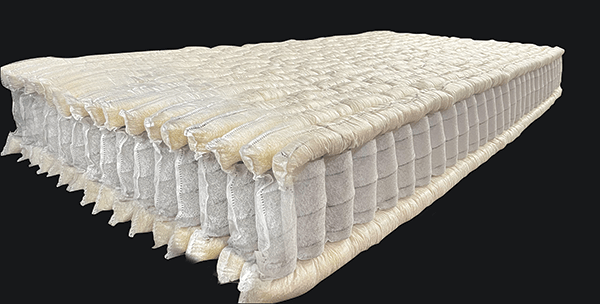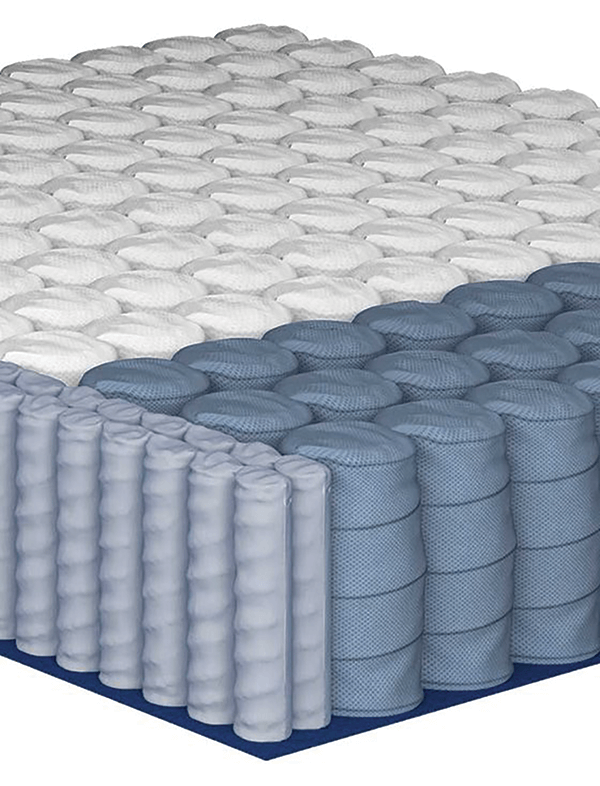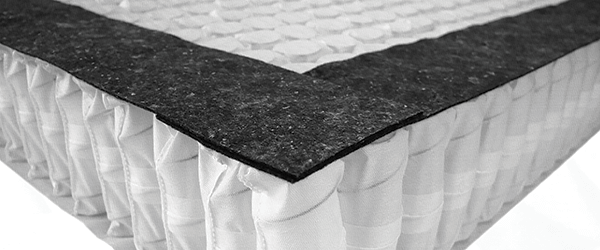Whether big or small, glued or glueless, coils continue to comfort and support sleepers.

When it comes to innerspring and hybrid mattresses, coils are a crucial component— customizable to achieve different goals, such as imbuing a product with support and comfort, maximizing airflow or saving on costs by requiring less foam or other materials. Sometimes, it’s all the above. Springs suppliers are taking into consideration mattress manufacturers’ needs, key trends in the marketplace and current industry challenges when it comes to development of machinery and new products to meet a variety of needs. From larger coils to glue-free assembly, one thing is clear — there will always be room to spring forward.
State of the industry
It’s no secret that the bedding industry is experiencing a bit of a slowdown. Sectorwide factors, including inflation, increased freight costs, and consumers taking a more discretionary approach to spending, have the industry experiencing a bit of turbulence. “I don’t think anyone would disagree that the last three years have been unprecedented in terms of volatile consumer demand, which presented challenges for the entire industry,” says Jason Jewett, vice president of product development for Leggett & Platt Inc., headquartered in Carthage, Missouri. “But it’s due time to pivot and refocus on what’s important to the end user of our products. Providing the consumer with an appropriate balance between comfort and performance has never been more important.”
Here, we dive into the latest developments in innersprings and some key trends in the
marketplace.
Bigger is sometimes better

At Interzum Cologne, Spinks launched Micro Plus, the company’s largest microcoil to date with a profile of 2 inches. Created in response to customer requests for a larger unit, it reduces cost by replacing some filling materials. The microcoils are suitable for a variety of mattress constructions ranging from hybrid to conventional innersprings.
After several years of launches of various low-profile comfort coils which seemed to ask, “How small can springs get?” some manufacturers have headed in the opposite direction, introducing their highest-profile coils. This has been a recent focus of Keene, Texas-based Texas Pocket Springs. “We’re seeing a trend for different height coils, not just for the low-profile comfort layer coils but also toward higher profile coils as manufacturers are looking to simplify their mattress builds and eliminate the use of so much foam,” says Matan Wolfson, director of business development for Texas Pocket Springs.
After moving to a new factory in March 2022 and installing all-new machinery, Texas Pocket Springs started making 9-inch and 10-inch coils to reduce the amount of foam needed per mattress. These higher profiles have between 884 and 1,008 coils in a queen-size unit, making them resilient while also reducing costs, Wolfson says. “The reality is, if you have a quality pocketed coil system, you don’t need so many layers on top,” he says. “Let the coil system work in the way it was designed to work. In this case, less is more.”
Over the past three months, bedding components supplier UT+C has launched 9-inch spring units to allow manufacturers to reduce the amount of foam used in mattresses while still retaining the overall high profile and feel they’re looking for. “It’s trying to get more bang for the buck because an inch of steel is cheaper than an inch of foam. So, it’s how big can we make the unit?” says Robert Loy, director of sales for UT+C, with North American headquarters in Danville, Virginia, and a factory in Nowe Skalmierzyce, Poland.
Size down
But it’s not one size fits all. On the shorter end of the spring spectrum, there is Micro 3D+, a microcoil launching soon from Leeds, England-based Spinks. Made with just two raw materials (polyester and steel), the steel microcoils are combined with a 3D polyester spacer fabric and then either welded or bonded with a polyester adhesive to create a finished pad. “So, it’s very easy to recycle at end of life but gives quite a nice marketing story behind it and something unique in the marketplace,” says Darren Marcangelo, managing director for Spinks.

Bags filled with crushed sponge, crushed latex and cotton line the top and bottom of Guangzhou Lianrou’s Cloud Foam Spring, creating a comfortable feel while its flexibility makes it ideal for adjustable bases.

Also on the lower profile side, Texas Pocket Springs launched the QuadMini Premium in July when the company added its latest minicoiling machines to its facilities. The product comes in a 3-inch, 1,900-coil-count unit for a queen and is a “true working coil with seven turns and a 4-inch preload, making the unit dimensions stable and easy to work with,” Wolfson says. Designed to mimic the feel of latex but at a lower cost, it eliminates nearly all body impressions and creates better airflow, resulting in a cooler sleep experience, he says. The product is also available with zoned and/or firm perimeter edges.
On the edge
Some developments have progressed in response to the popularity of certain products, such as the widespread adoption of boxed beds, especially hybrid models, according to Brian Akchin, vice president of sales for Windsor, Connecticut-based A&S Innersprings. “Foam encasements do not perform as well as full-perimeter innersprings that have enhanced edge support in a roll and fold product,” he says. Akchin believes one of the biggest recent developments in the industry is the reinforced perimeters on pocket coil units, rather than foam encasements. “Developing a unit that works really well for the hybrid market, in the (boxed bed) industry was a primary focus of our company for the past two years, and it has come to fruition in the past 12 months,” he says.


Going glueless
The industry is considering whether it can manufacture products without glue, which can be an obstacle to recycling used mattresses.
“More and more, customers are looking for environmentally friendly products to reduce the use of foam and glue and to reduce labor costs and reduce the use of floor space,” says Ken Tsai, sales manager at Guangzhou Lianrou Machinery & Equipment Co. Ltd. In response, the Guangzhou, China-based company introduced two types of spring units in 2022.
Lianrou’s Cloud Foam Spring features a layer of wrapped springs in the center of the unit with top and bottom comfort layers of foam or a choice of wool, feathers or cotton. Between the spring and comfort layers there is no glue, just ultrasonic joining. Both layers are produced at the same time by one machine, saving on floor space, as it reduces the number of machines needed to produce one product. It also saves on labor, due to the fewer steps needed.
The Double Layer Spring, a double-layer pocket spring unit, features thick wire on the bottom layer for support and thin wire on the top layer for comfort. Both layers are also produced at the same time by one machine.
Another innovation is Texas Pocket Springs’s second-generation glueless machine, the 2023 GenEco Pocket Coil Assembly System, which was slated to launch at the end of September. “It makes a 100% glue-free pocketed coil unit which makes the unit 100% recyclable,” says Matan Wolfson, director of business development for Texas Pocket Springs. “This gives mattress companies a sustainable story and substantial savings by eliminating glue.”

At Interzum Cologne in Germany, Matsushita debuted its cotton pocket spring machine, the PKT-CT. The finished pocket springs use natural cotton fabric instead of the more traditional nonwoven fabric.

PKTA-CT, a cotton pocket assembling machine from
Matsushita Industrial Co. Ltd., uses C-ring clips instead of
hot-melt adhesive to join the units together.
Of the machine’s development, Martin Wolfson, owner and chief executive officer of Texas Pocket Springs, says, “After strenuous testing, the conclusion was obvious that glue was the weakest point in a pocketed coil innerspring unit, so our goal was to eliminate the use of glue to bond the coils together. This initiated the creation of our patented glueless technology.”
Glue can also create other problems during transportation, he says. Temperature extremes during transportation can compromise the glue’s viscosity and bond, which could lead to warping, particularly in roll-packed units. The thermal bonding of the fabric creates a seal that is more durable than glue and, according to Martin Wolfson, the fabric will not suffer a loss of integrity.
While some companies are making progress in creating glueless products, others are finding ways to innovate while retaining the adhesive, albeit with a fresh approach. In addition to glueless solutions, A&S Innersprings, part of Agro Group, has partnered with glue producers to develop a product for polyester and polypropylene nonwovens for recycling that does not require separation from the nonwoven. The company recently launched its PP glue range in Europe, and A&S will introduce the PP glue products to the U.S. market in the first quarter of 2024. “We are the first to offer a pocket coil utilizing a fabric and glue of the same composition, eliminating the need to separate them for recycling,” Akchin says. In the United States, once launched, the new glue will be in all A&S Innersprings products. “We are constantly looking for ways to improve product for the marketplace and to provide our customers with a better and more sustainable platform to build their mattress on,” he says.
Sustainability matters
Sustainability continues to be a hot topic across many segments of the sleep products industry — in products, processes and facilities — and many springs manufacturers are taking stock and finding ways to be more eco-friendly. It’s safe to say that for some companies, sustainability is a value baked into its core business model and approach.
This year, Leggett & Platt Inc introduced Eco-Base, a line of products designed to contribute to industry sustainability efforts and increase mattress manufacturing efficiencies without sacrificing what’s important to the consumer — comfort. EcoBase replaces the common practice of applying base foam to the bottom of the core innerspring support layer. Instead, it adds a substrate that serves the same purpose as base foam yet provides an appreciable reduction in petrochemical content, Jewett says. The line offers mattress manufacturers the opportunity to reduce costs and invest the savings into the comfort layer of the mattress where it has the most impact on the consumer experience, he says.

UT+C offers felt padding in its Frame Unit. The padding
can be applied head to foot on all four sides,
on one side or both.

Springs Anywhere, a patented product from Spinks, creates the ability for phased zoning so that it’s not necessary to use the same coil across the width of the sheet, bringing flexibility and comfort to mattress builds.
On the machinery side, “we’ve also seen some great innovation around equipment to process pocket coils at end of life,” Jewett says. “Over the last few years, the process has become much friendlier with automated equipment that separates the fabric shell from the steel coils allowing each to flow into the appropriate recycling stream.”
According to Yukitoshi Matsushita, president of Nagasaki, Japan-based Matsushita Industrial Co. Ltd., the company is working on several sustainability initiatives, such as developing a sewing machine “for carton sewing instead of hot-melt adhesive bonding in the packing industry.” At Interzum Cologne in May, Matsushita exhibited two of its latest machines, PKT-CT (a cotton pocket spring machine) and PKTA-CT (a cotton pocket assembling machine). Looking ahead to 2024, the company plans to upgrade its cotton pocket spring machine and cotton pocket assembling machine to an automatic line, including automatic cutting and assembly.
Over at UT+C, the supplier has been approaching sustainability from several different angles. In 2021, the company received ISO 50001:2018 certification, building on its prior ISO 9001:2015 certification. It also has plans to build a heat and power station (pending approval) at its facility in Poland that will be able to generate energy from refuse-derived fuel. This clean energy source repurposes solid waste and diverts it from going to landfills. UT+C has also installed solar panels on top of its factory and has converted all its facilities’ natural gas-fueled forklifts to electric-powered ones.
In the zone
While sustainability remains an ongoing area of focus, Spinks’ Marcangelo points out another — zoning. “Zoning in core innersprings has been around for a long time. But what a lot of our customers are finding, especially in Europe, is that it is cheaper and makes the mattress feel good when you put the zoning closer to the sleep surface.” Spinks also has two patented products in development, one of which is “a next-generation hybrid material featuring a coil with a filling material that has never been done before,” Marcangelo says. That’s all he can reveal for now — but stay tuned. Both will debut in 2024.
Despite the bedding industry downturn, springs producers continue to find ways to show up for their customers with novel products. “As far as navigating forward, it’s a matter of making sure you keep a focus on innovation, managing your business effectively and providing comfort,” Jewett says.
Doug Guffey, senior vice president of sales for Atlanta Attachment Co. and Hickory Springs Manufacturing, adds: “Tough times produce some of the best people, products and processes. We hope to help our customers in finding those key elements.”




